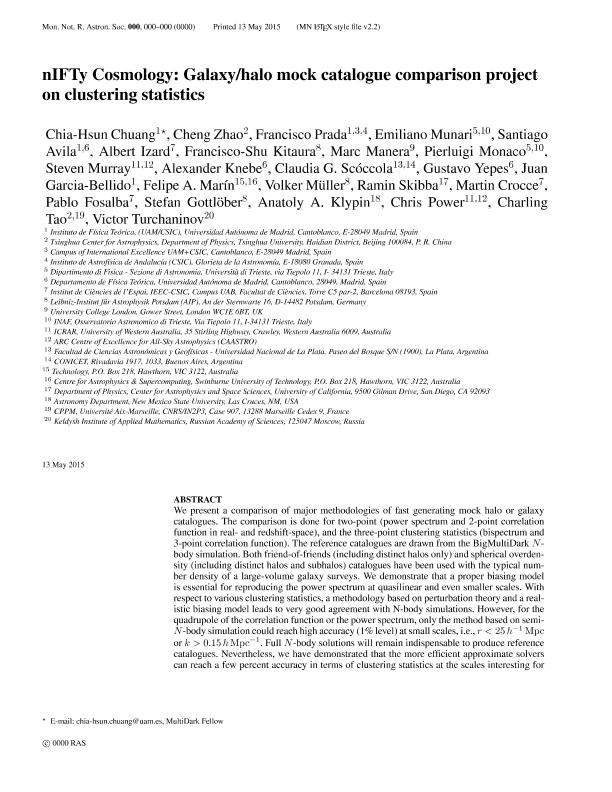Artículo
nIFTy Cosmology: Galaxy/halo mock catalogue comparison project on clustering statistics
Chuang, Chia Hsun; Zhao, Cheng; Prada, Francisco; Munari, Emiliano; Avila, Santiago; Izard, Albert; Kitaura, Francisco Shu; Manera, Marc; Monaco, Pierluigi; Murray, Steven; Knebe, Alexander; Scoccola, Claudia Graciela ; Yepes, Gustavo; Garcia Bellido, Juan; Marín, Felipe A.; Müller, Volker; Skibba, Ramin; Crocce, Martin; Fosalba, Pablo; Gottlöber, Stefan; Klypin, Anatoly A.; Power, Chris; Tao, Charling; Turchaninov, Victor
; Yepes, Gustavo; Garcia Bellido, Juan; Marín, Felipe A.; Müller, Volker; Skibba, Ramin; Crocce, Martin; Fosalba, Pablo; Gottlöber, Stefan; Klypin, Anatoly A.; Power, Chris; Tao, Charling; Turchaninov, Victor
 ; Yepes, Gustavo; Garcia Bellido, Juan; Marín, Felipe A.; Müller, Volker; Skibba, Ramin; Crocce, Martin; Fosalba, Pablo; Gottlöber, Stefan; Klypin, Anatoly A.; Power, Chris; Tao, Charling; Turchaninov, Victor
; Yepes, Gustavo; Garcia Bellido, Juan; Marín, Felipe A.; Müller, Volker; Skibba, Ramin; Crocce, Martin; Fosalba, Pablo; Gottlöber, Stefan; Klypin, Anatoly A.; Power, Chris; Tao, Charling; Turchaninov, Victor
Fecha de publicación:
08/04/2015
Editorial:
Wiley Blackwell Publishing, Inc
Revista:
Monthly Notices of the Royal Astronomical Society
ISSN:
0035-8711
e-ISSN:
1365-2966
Idioma:
Inglés
Tipo de recurso:
Artículo publicado
Clasificación temática:
Resumen
We present a comparison of major methodologies of fast generating mock halo or galaxy catalogues. The comparison is done for two-point (power spectrum and two-point correlation function in real and redshift space), and the three-point clustering statistics (bispectrum and three-point correlation function). The reference catalogues are drawn from the BigMultiDark N-body simulation. Both friend-of-friends (including distinct haloes only) and spherical overdensity (including distinct haloes and subhalos) catalogues have been used with the typical number density of a large volume galaxy surveys. We demonstrate that a proper biasing model is essential for reproducing the power spectrum at quasi-linear and even smaller scales. With respect to various clustering statistics, a methodology based on perturbation theory and a realistic biasing model leads to very good agreement with N-body simulations. However, for the quadrupole of the correlation function or the power spectrum, only the method based on semi-N-body simulation could reach high accuracy (1 per cent level) at small scales, i.e. r < 25 h-1 Mpc or k > 0.15 h Mpc-1. Full N-body solutions will remain indispensable to produce reference catalogues. Nevertheless, we have demonstrated that the more efficient approximate solvers can reach a few per cent accuracy in terms of clustering statistics at the scales interesting for the large-scale structure analysis. This makes them useful for massive production aimed at covariance studies, to scan large parameter spaces, and to estimate uncertainties in data analysis techniques, such as baryon acoustic oscillation reconstruction, redshift distortion measurements, etc.
Archivos asociados
Licencia
Identificadores
Colecciones
Articulos(CCT - LA PLATA)
Articulos de CTRO.CIENTIFICO TECNOL.CONICET - LA PLATA
Articulos de CTRO.CIENTIFICO TECNOL.CONICET - LA PLATA
Citación
Chuang, Chia Hsun; Zhao, Cheng; Prada, Francisco; Munari, Emiliano; Avila, Santiago; et al.; nIFTy Cosmology: Galaxy/halo mock catalogue comparison project on clustering statistics; Wiley Blackwell Publishing, Inc; Monthly Notices of the Royal Astronomical Society; 452; 1; 8-4-2015; 686-700
Compartir
Altmétricas



